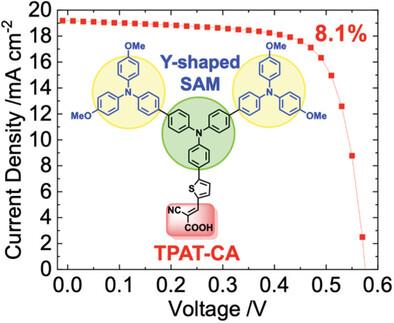Triphenylamine‐Based Y‐Shaped Self‐Assembled Monolayers for Efficient Tin Perovskite Solar Cells
IF 13
2区 材料科学
Q1 CHEMISTRY, MULTIDISCIPLINARY
引用次数: 0
Abstract
Triphenylamine‐based Y‐shaped organic sensitizers, specifically TPA‐MN (1), TPA‐CA (2), TPAT‐MN (3), and TPAT‐CA (4), are synthesized and utilized as

基于三苯胺的 Y 型自组装单层材料用于高效锡过氧化物太阳能电池
我们合成了三苯胺基 Y 型有机敏化剂,特别是 TPA-MN (1)、TPA-CA (2)、TPAT-MN (3) 和 TPAT-CA (4),并将其用作锡基过氧化物太阳能电池 (TPSC) 的 p 型自组装单层 (SAM)。这些 SAM 是使用低成本的起始材料(主要来自三苯胺 (TPA) 成分)开发的。对 SAM 1-4 的结晶、形态、热、光学、电化学和光电特性进行了广泛的分析,并对结果进行了比较。采用两步法成功地在所有四种 SAM 表面上形成了锡包晶层。所得器件按以下顺序显示出 PCE:TPAT-CA(8.1%);TPAT-MN(6.1%);TPA-MN(5.0%);TPA-CA(4.2%)。含有噻吩间隔的 TPAT-CA 分子在快速空穴萃取率、高空穴迁移率和延迟电荷重组方面的表现优于其他三种 SAM。因此,SAM TPAT-CA 表现出最高的器件性能和卓越的长期稳定性,在存储 3000 小时后,其性能仍能保持≈90%的初始值。 本研究中描述的创新型 Y 型 SAM 具有设计简单、效率高的特点,有望为促进过氧化物光伏技术的发展,特别是在开发具有成本效益的 TPSC 技术方面做出重大贡献。
本文章由计算机程序翻译,如有差异,请以英文原文为准。
求助全文
约1分钟内获得全文
求助全文
来源期刊

Small
工程技术-材料科学:综合
CiteScore
17.70
自引率
3.80%
发文量
1830
审稿时长
2.1 months
期刊介绍:
Small serves as an exceptional platform for both experimental and theoretical studies in fundamental and applied interdisciplinary research at the nano- and microscale. The journal offers a compelling mix of peer-reviewed Research Articles, Reviews, Perspectives, and Comments.
With a remarkable 2022 Journal Impact Factor of 13.3 (Journal Citation Reports from Clarivate Analytics, 2023), Small remains among the top multidisciplinary journals, covering a wide range of topics at the interface of materials science, chemistry, physics, engineering, medicine, and biology.
Small's readership includes biochemists, biologists, biomedical scientists, chemists, engineers, information technologists, materials scientists, physicists, and theoreticians alike.
 求助内容:
求助内容: 应助结果提醒方式:
应助结果提醒方式:


